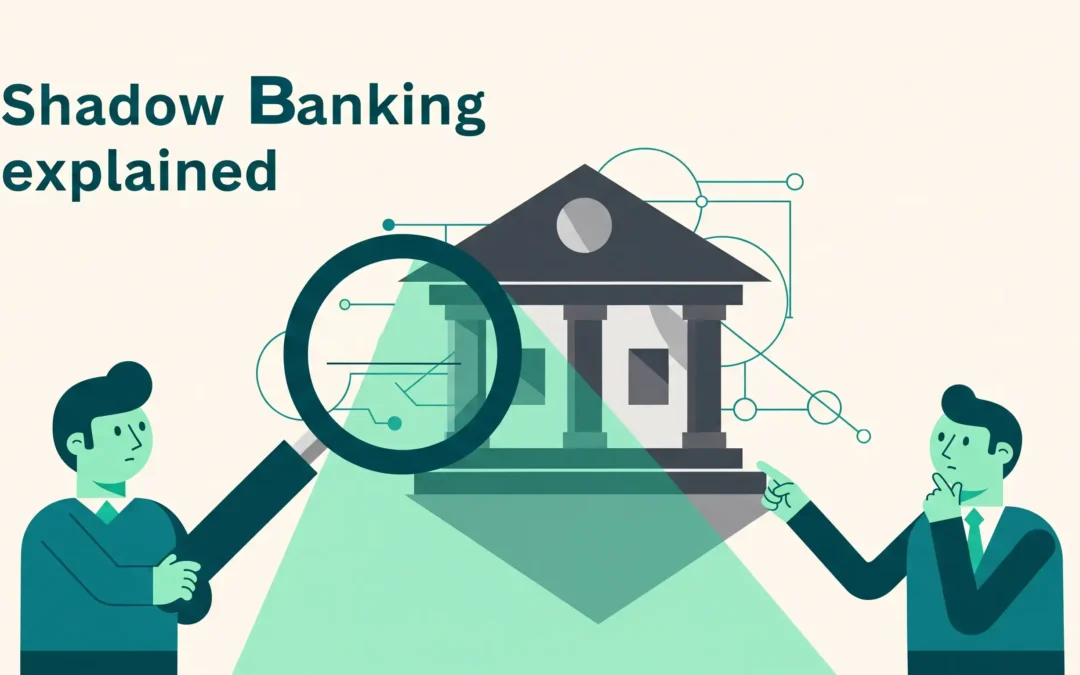In an economy, all financial institution, such as banks, plays an important role. But there are other factors and intermediaries that are crucial for a better functioning of the economy. Shadow banking is one such non-banking facility that generates higher returns but at a higher degree of risk.
This article will help you understand the concept of shadow banking along with its effect on savers and SMEs. It will help you make an informed decision if it is the right choice or not.
What is Shadow Banking?
Financial intermediaries that offer banking-like services, such as lending and investing, but do so without a banking licence or complete regulatory oversight, are referred to as “shadow banks.” These consist of things like:
- Financial firms that are not banks (NBFCs)
- Platforms for peer-to-peer (P2P) lending
- Funds for hedges
- Securitisation firms
- Funds for money markets
Key Features:
- Functions outside of the conventional banking structure.
- Provides the market with credit and liquidity.
- More risk due to less regulation
- Typically caters to underserved or niche markets (small businesses, subprime borrowers, etc.).
- Promises greater profits, but frequently at greater risk.
How Shadow Banking Affects Everyday Savers?
Let us look at its effect on everyday users:
1. Greater Returns at Higher Risks
Returns offered by some shadow banks, such as certain NBFCs and P2P lending platforms, can sometimes exceed those of traditional bank deposits, but this is not always the case. Higher returns are typically accompanied by higher risks, and not all shadow banking products consistently outperform bank deposits.
However, it is important to consider the risk elements like:
- Lack of deposit insurance in contrast to banks, which provide DICGC protection of up to Rs. 5 lakhs.
- Capital is not assured: defaults may cause an investment to be lost entirely or in part.
- Low liquidity: Some shadow banking products may restrict early withdrawal or impose penalties, though liquidity varies certain instruments like traded NBFC bonds or some mutual funds may allow easier exit than others.
2. Limited Transparency and Regulation
Investors are blind spots because shadow banks are exempt from the stringent regulations that apply to commercial banks.
- Minimal regulatory supervision increases the degree of risk
- Requirements for reporting are less strict
- No required risk buffers or reserve ratios
Concerns about transparency:
- Insufficient details about the investment process
- No guarantee of prompt repayment or early departure
- Disclosures and auditing could be delayed
3. Indirect Exposure via Mutual Funds
If a debt mutual fund invests in corporate or NBFC debt, even conservative investors may be exposed to shadow banking risks.
Procedures:
- For higher returns, mutual funds frequently purchase bonds or commercial papers issued by NBFCs.
- Investors are directly impacted if the issuer defaults because the NAV (Net Asset Value) declines.
4. The Mainstreaming of Shadow Products Through Fintech Apps
These days, financial apps and online platforms expose savers to shadow banking more and more.
- Easy access to “high-yield” options, quick onboarding, and slick interfaces
- P2P lending, NBFC bonds, and invoice discounting are now accessible with a single tap.
5. How Self-Preservation Is Possible for Savers
When interacting with products linked to shadow banking, savers must be cautious and knowledgeable. Prior to making an investment, make sure:
- NBFC or platform credit rating (look for CRISIL/ICRA AA+ or above)
- Lock-in time, exit fees, and the possibility of early withdrawals
- If SEBI, the RBI, or another financial regulator regulates the product
Advice for risk management:
- Keep your portfolio’s exposure to shadow banking to no more than 10% to 15%.
- Steer clear of high-risk investments with your emergency fund.
Maintain a variety of
- FDs from banks
- Government securities
- Mutual funds with minimal exposure to NBFCs
- SIPs for long-term growth in large-cap equity funds
- Shadow Banking and Its Role in Financing SMEs
Shadow Banking and Its Role in Financing SMEs
The importance of SMEs cannot be ignored in an economy. Let us look at how shadow banking impacts them:
- Compared to traditional banks, shadow banks such as NBFCs and fintech lenders offer quicker and more flexible credit solutions, particularly for SMEs without formal credit history or collateral.
- Working capital and short-term funding needs can be disbursed more quickly thanks to these institutions’ evaluation of creditworthiness based on cash flows and business performance.
- Simplified paperwork, customised loan options, and quick access to capital all help SMEs grow, expand, and maintain operations.
- Borrowers’ financial risk is raised by shadow banking loans, which often have higher interest rates, shorter repayment terms, and more stringent recovery procedures.
- For SMEs to successfully use shadow banking without getting into a debt trap, responsible borrowing, term comparison, and a realistic assessment of repayment capacity are crucial.
Bottomline
The conclusion can be drawn that Shadow banking products may offer the potential for higher returns, but they come with significantly higher risks than traditional bank deposits. Savers should only allocate a limited portion of their portfolio to such investments, balancing risk and return according to their financial goals and risk tolerance.
It provides loans to SMEs with less hassle of paperwork and in a quicker manner. However, they are not mainstream and hence are not regulated by the strict rules and regulations.
It is advised to weigh the pros and cons before making an informed decision to avoid any extra cost in the future.


